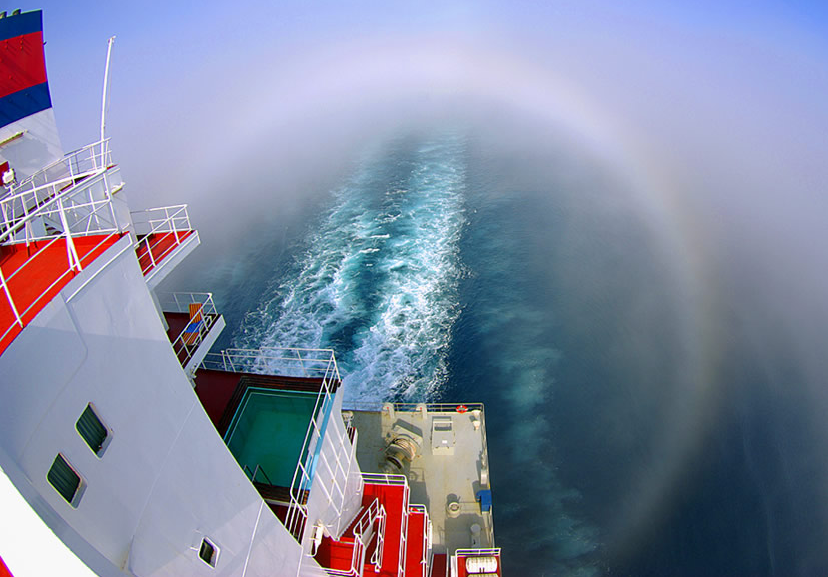Fogbow, Titanic Waters
Fogbow: Exploring the Enigmatic Beauty of Titanic Waters
When it comes to atmospheric optics, there are few phenomena as captivating as the fogbow. Often referred to as a white rainbow, fogbows possess an ethereal charm that sets them apart from their colorful counterparts. These elusive spectacles can be observed in regions where fog blankets the landscape, creating an enchanting display of light and mist.
Similar to rainbows, fogbows are formed through the refraction and reflection of sunlight in water droplets. However, there are some intriguing differences that make fogbows unique. The droplets in fog are much smaller than raindrops, which introduces an additional process called diffraction. Diffraction occurs when light waves interfere with each other, causing the fogbow to broaden and its colors to appear more subdued and pastel-like.
To witness the awe-inspiring sight of a fogbow, one must venture into areas where fog is prevalent. Picture yourself aboard a container ship, sailing across the vast expanse of the Atlantic Ocean towards Newfoundland. As the ship cuts through the dense fog, you find yourself standing at the stern, gazing out into what can only be described as "Titanic waters." It is here that you spot a mesmerizing fogbow gracing the horizon.
The beauty of a fogbow lies not only in its ethereal appearance but also in its elusiveness. Unlike rainbows, which are commonly observed after rainfall, fogbows are more elusive and require specific atmospheric conditions to form. The interplay between sunlight, tiny fog droplets, and diffraction creates a spectacle that is both mysterious and captivating.
To fully appreciate the intricacies of fogbows, it is essential to understand the science behind their formation. As sunlight passes through the tiny fog droplets, it undergoes refraction, bending the light rays. This bending causes the different colors of light to separate, similar to how a prism disperses light. However, unlike rainbows, where the droplets are larger and the colors appear vibrant, the smaller droplets in fog result in a broader bow and more subdued colors.
The enchanting allure of fogbows has fascinated scientists and photographers alike. Capturing the delicate beauty of these atmospheric phenomena requires both patience and skill. The soft pastel hues and ethereal glow make fogbows a subject of intrigue for photographers seeking to capture the essence of nature's artistry.
In addition to their aesthetic appeal, fogbows also serve as a reminder of the interconnectedness of various atmospheric phenomena. Understanding the formation of fogbows contributes to our knowledge of light refraction, diffraction, and the behavior of water droplets in different atmospheric conditions. This knowledge can have practical applications in meteorology and atmospheric science.
As we continue to explore the wonders of atmospheric optics, the enigmatic beauty of fogbows reminds us of the intricate processes occurring in our atmosphere. These ethereal spectacles serve as a testament to the delicate balance between light, water, and air. So next time you find yourself in the presence of fog, keep an eye out for the elusive fogbow – a captivating display that will transport you into a realm where nature's artistry reigns supreme.

Fogbow south east of Newfoundland imaged by Juerg Alean (site, more voyage images, Stromboli online) from the stern of a container ship as it thundered across 'Titanic waters'.
©Juerg Alean, shown with permission.
Fogbow form like rainbows by sunlight refraction and reflection in water drops.
Fog droplets are much smaller than raindrops and another process becomes important. Diffraction - interference between light waves - broadens the bow and renders the colours more pastel.
Fogbows
Droplets & diffraction
Fogbows & rainbows
Note: this article has been automatically converted from the old site and may not appear as intended. You can find the original article here.
Reference Atmospheric Optics
If you use any of the definitions, information, or data presented on Atmospheric Optics, please copy the link or reference below to properly credit us as the reference source. Thank you!
-
<a href="https://atoptics.co.uk/blog/fogbow-titanic-waters/">Fogbow, Titanic Waters</a>
-
"Fogbow, Titanic Waters". Atmospheric Optics. Accessed on April 19, 2024. https://atoptics.co.uk/blog/fogbow-titanic-waters/.
-
"Fogbow, Titanic Waters". Atmospheric Optics, https://atoptics.co.uk/blog/fogbow-titanic-waters/. Accessed 19 April, 2024
-
Fogbow, Titanic Waters. Atmospheric Optics. Retrieved from https://atoptics.co.uk/blog/fogbow-titanic-waters/.